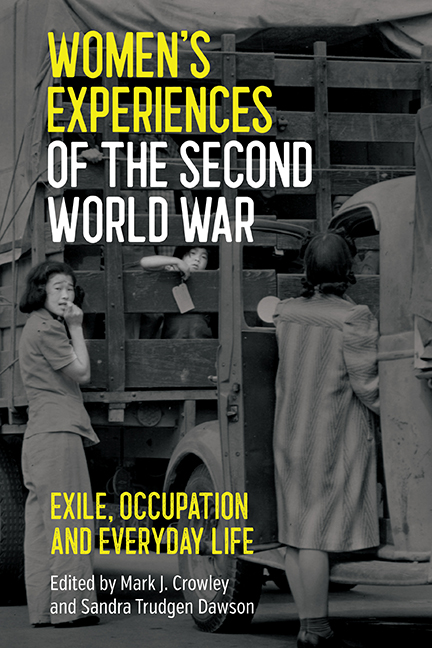Book contents
- Frontmatter
- Dedication
- Contents
- List of Illustrations
- List of Contributors
- Acknowledgements
- List of Abbreviations
- Introduction: Women’s Experiences of the Second World War: Exile, Occupation and Everyday Life
- Part One Living in Exile and under Wartime Occupation
- Part Two Living with Wartime Occupiers
- Part Three Everyday Life at Home and on the Battle Front
- Index
9 - ‘We had all tried to act like ladies, but we weren’t getting anywhere.’: The Bring Back Daddy Clubs and the Demobilization of 1945
Published online by Cambridge University Press: 03 June 2021
- Frontmatter
- Dedication
- Contents
- List of Illustrations
- List of Contributors
- Acknowledgements
- List of Abbreviations
- Introduction: Women’s Experiences of the Second World War: Exile, Occupation and Everyday Life
- Part One Living in Exile and under Wartime Occupation
- Part Two Living with Wartime Occupiers
- Part Three Everyday Life at Home and on the Battle Front
- Index
Summary
As the War department began planning for the largest U.S. armed forces engagement of the Second World War in September 1943, it simultaneously planned for the return and demobilization of eight million soldiers at the end of the war. Chief of Staff, General George Marshall, stipulated that soldiers who served in combat should come home before those who were newly arrived in the theaters of war. This policy was a reaction to the perception that combat soldiers had waited to return from France after the Great War while fresh recruits were demobbed quickly. As Marshall told the nation in a 10 May 1945 address, the objectives were to ‘determine what standards the enlisted men themselves believed should be taken into account in establishing priority of separation from the Army, and second, to see to it that these standards were applied on a basis that would actually insure the release of men as individuals in the fairest manner’. The plan, released in 1944, depended on a simple point system. Soldiers received one point for each month served. Additional points were given for each month served overseas. Servicemen received five points for each combat decoration received (this satisfied Marshall's stipulation about combat soldiers), and an additional eight points for each child under the age of 18. The system was referred to in War Department documents as the 1:1:5:8 plan. In theory both civilians and soldiers liked the plan. One of the underlying principles, however, was the belief that the Pacific war would not end until 1947 or 1948. When it became clear that some soldiers would have to wait while others were transported home, some servicemen and civilians were upset – some were upset enough to act. From September 1945 to June 1946, all across the U.S., wives of servicemen organized a pressure movement to accelerate demobilization.
The first of these groups, the Service Wives and Children Association, formed in Pittsburgh in September 1945. Mrs. Patricia Coffey ran a simple ad in the Pittsburg Press: ‘Attention – calling all mothers whose husbands are in the service’. Coffey included her phone number and received 500 calls. Ultimately, the Pittsburgh Service Wives and Children Association (SWCA) formed with 300 members. Although Coffey founded the organization, Nancy Mueller became president, and Dorothy Galomb and Nellie Hopkins served as secretary and treasurer, respectively.
- Type
- Chapter
- Information
- Women's Experiences of the Second World WarExile, Occupation and Everyday Life, pp. 151 - 170Publisher: Boydell & BrewerPrint publication year: 2021



